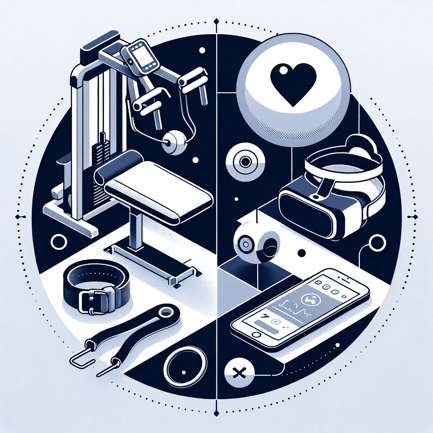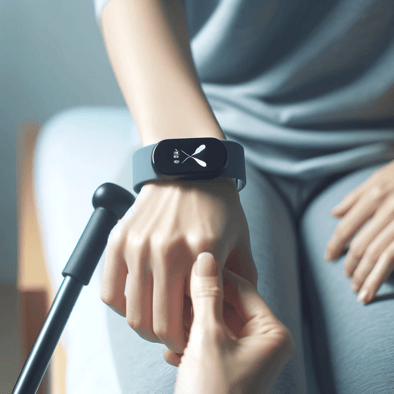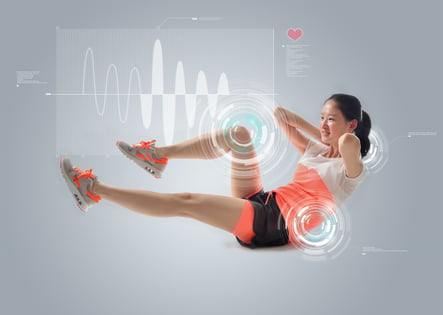January 10, 2024
8 Ways Technology in Physical Therapy Is Revolutionizing Rehab
Physical therapy, once confined to dimly lit rooms and repetitive exercises, is undergoing a radical transformation. New and cutting-edge technology in physical therapy is redefining the field, making it more accessible, effective, and engaging than ever before.
From telehealth consultations to AI-powered treatment plans, the digital revolution is empowering physical therapists and propelling patient outcomes to new heights.
The Importance of Physical Therapy Technology

In the ever-evolving landscape of healthcare, physical therapy holds the key to regaining mobility, managing pain, and enhancing quality of life. But technology isn't just a spectator in this journey – it's a catalyst. From early innovations like NEMS and LLLT to modern marvels like practice management software and AI-powered therapy plans, technology continuously propels physical therapy forward, leading to faster recovery, more effective treatments, and improved patient outcomes.
Think of it this way: technology in physical therapy acts as a force multiplier in the hands of skilled PTs. It expands their reach, allowing them to connect with patients in distant locations through telehealth. It enhances their precision, utilizing sensors and biofeedback to monitor progress and personalize treatment plans. And it fosters engagement, gamifying exercises and making rehabilitation a more interactive, rewarding experience.
The benefits of embracing technology in physical therapy are undeniable. Patients experience:
- Faster recovery timelines: Technology like robotic exoskeletons and VR environments can accelerate rehabilitation, leading to quicker regaining of mobility and function.
- Reduced pain and improved management: Techniques like TENS and biofeedback can effectively manage pain, allowing patients to participate more actively in their treatment.
- Enhanced accuracy and personalized care: Wearable sensors and data analysis tools provide therapists with a wealth of data to tailor treatment plans to individual needs and optimize each session's effectiveness.
- Greater accessibility and convenience: Telehealth removes geographical barriers and busy schedules, making physical therapy accessible to everyone, regardless of location or time constraints.
Ultimately, PT technology empowers physical therapists to deliver better care, while empowering patients to actively participate in their own recovery journey. It's a win-win scenario that paves the way for a brighter future, where physical therapy is not just a treatment option, but an innovative force for good.
8 Reasons Why Physical Therapy Technology is Transforming Rehabilitation
While physical therapy has traditionally relied on manual techniques and exercise programs, a new era dawns powered by cutting-edge technologies. Let's delve deeper into their transformative potential,
1. Telehealth: Breaking Down Barriers, Building Relationships
The physical therapy landscape is no longer confined to brick-and-mortar clinics. Thanks to telehealth, geographical barriers crumble, opening doors to accessible, convenient care for everyone. Imagine individuals in remote towns, those with chronic conditions limiting mobility, or even busy professionals – all accessing expert help from the comfort of their homes.
Combination of Telehealth with EMR Systems
Platforms like PtEverywhere seamlessly integrate video conferencing with a powerful electronic medical record (EMR) system. This means your therapist isn't just seeing you through a screen. They have instant access to your complete medical history, past diagnoses, and treatment plans. Gone are the days of carrying bulky files or relying on fragmented information.
Telehealth, powered by advanced EMRs like PtEverywhere, fosters closer patient-therapist relationships. Regular check-ins, accessible messaging features, scheduling options, and the ability to share educational resources create a supportive environment where you feel truly seen and heard. No more lengthy commutes or missed appointments – telehealth puts you in control, empowering you to actively participate in your own recovery journey.
PtEverywhere's secure cloud-based EMR fosters transparent communication and collaboration. Your therapist can review your progress, personalize exercises based on your unique needs, and track your vitals and responses in real-time. This dynamic feedback loop allows for constant adjustments, ensuring your treatment remains on track and optimized for maximum recovery.
So, whether you're facing geographical limitations, battling physical challenges, or simply seeking a flexible approach to healthcare, telehealth offers a revolutionary solution. With PtEverywhere and similar platforms powering the next generation of physical therapy, you can experience care that fits seamlessly into your life, building not just stronger bodies but also stronger connections with your therapist.
2. Neuromodulation Techniques: Stepping Beyond Muscle and Bone
New Physical therapy technology is now tapping into the power of the nervous system to accelerate healing. Non-invasive brain stimulation techniques like transcranial magnetic stimulation (TMS) and transcranial direct current stimulation (tDCS) are being explored for their potential to modulate pain, improve motor control, and enhance rehabilitation outcomes.
Picture a scenario where a therapist uses TMS to stimulate specific brain regions, facilitating neuroplastic changes and enhancing the effectiveness of traditional exercises.
Studies have shown that TMS and tDCS can help to reduce pain and improve motor control. Further research is needed to determine the full potential of these techniques.
3. Wearables: Quantifying the Road to Recovery
Gone are the days of relying solely on subjective assessments. Wearable sensors, like smartwatches and activity trackers, are becoming indispensable tools in physical therapy. These devices collect a wealth of data, from gait patterns and range of motion to muscle activity and sleep quality. Therapists can leverage this data to personalize treatment plans, track progress objectively, and identify areas for improvement.
Imagine a sensor-equipped sleeve that monitors muscle activation during bicep curls, allowing the therapist to fine-tune the exercise for optimal muscle engagement. This data-driven approach not only enhances treatment efficacy but also empowers patients to take an active role in their recovery journey.
4. Gamification: Making Rehabilitation Fun and Engaging
Physical therapy exercises can sometimes feel monotonous, leading to decreased motivation and adherence. Gamification, the art of incorporating game-like elements into rehabilitation, is injecting a dose of fun and engagement into the process.
Imagine a virtual reality environment where patients navigate obstacle courses or battle virtual monsters, all while strengthening muscles and improving coordination. Gamification not only makes therapy more enjoyable but also increases motivation, leading to better outcomes.
A study published in the Journal of Physical Therapy found that gamified balance training exercises resulted in significantly greater improvements in balance and gait stability compared to traditional therapy methods.
5. AI-powered Rehabilitation: The Future is Now
Artificial intelligence (AI) is no longer science fiction - it's making its mark on physical therapy. AI-powered software is being used to analyze data from wearable sensors and cameras, providing real-time feedback and guidance to patients.
Consider an AI system that analyzes a patient's posture during squats and offers corrective feedback in real-time, ensuring proper form and maximizing the effectiveness of the exercise. This personalized approach, powered by AI, holds immense promise for optimizing treatment plans and accelerating recovery times.
Indeed, it’s only a matter of time when AI becomes a staple technology in therapy.
 6. Robotics: Augmenting Human Potential with Intelligent Machines
6. Robotics: Augmenting Human Potential with Intelligent Machines
Rehabilitation is no longer a solitary endeavor. Advanced robotics in physical therapy, like those described by the National Institute of Biomedical Imaging and Bioengineering (NIBIB), step in as our partners in recovery.
Exoskeletons, mimicking the human musculoskeletal system, augment movement and provide targeted assistance, facilitating faster progress in individuals with spinal cord injuries.
These intelligent machines, fueled by AI and sensor technology used in physical therapy, not only personalize training but also collect valuable data on muscle activation, fatigue, and recovery, allowing therapists to continuously adjust interventions for optimal results.
7. Virtual Reality: Measurably Recovering Mind and Body
Move beyond static exercises and enter interactive virtual reality, where VR becomes a potent therapeutic tool. Studies published by the National Institutes of Health (NIH) report significant improvements in balance and gait stability using VR-based balance training compared to traditional methods.
Imagine stroke patients regaining functional movement by navigating virtual obstacle courses or battling virtual opponents, all while real-time data on their motion and performance is captured for therapist analysis and treatment optimization.
This data-driven approach, as highlighted by the Centers for Disease Control and Prevention (CDC), holds immense potential for personalized interventions and objective outcome tracking, paving the way for more effective and targeted rehabilitation plans.
8. Bioprinting and Tissue Engineering: Regenerating Life at the Cellular Level
Forget prosthetics and envision new limbs grown from your own cells. Bioprinting and tissue engineering, championed by the National Science Foundation (NSF), stand poised to revolutionize rehabilitation for individuals with debilitating injuries or organ dysfunction.
3D printing technology, combined with advances in biocompatible materials and cell differentiation, promises the creation of personalized implants and scaffolds that seamlessly integrate with the body.
A recent study published in Nature Medicine demonstrated the successful printing of functional human heart tissue, opening doors for the potential regeneration of damaged organs and tissues in the future. This transformative PT technology, while still in its early stages, holds immense promise for a future where pain-free movement and restored function are not just dreams but tangible realities.
Practice Management Software: Fueling the Revolution

Beyond telehealth and scheduling, a hidden engine fuels the revolution in physical therapy – practice management software like PtEverywhere. Imagine a central hub streamlining every aspect of your clinic.
- Streamlined Central Hub: PtEverywhere manages clinic tasks from intake to reporting.
- Time and Accuracy Savings: Automated forms and online payments expedite onboarding.
- Efficient Billing: Integrated superbill templates and CPT codes handle claims, reduce errors, and boost revenue.
- Smooth Operations: Inventory tools track supplies, preventing shortages.
- Insightful Reports: PtEverywhere generates data-driven insights into clinic performance.
- Empowering Care: Allows focus on delivering exceptional patient care.
Embracing New Technology in Physical Therapy
The landscape of rehabilitation is rapidly evolving, fueled by innovative technology in physical therapy fields like telehealth, robotics, and comprehensive practice management solutions. By embracing these advancements, you have the power to revolutionize care, reach new patients, and maximize your clinic's potential.
So, step into the future, equip yourself with the tools of change like PtEverywhere, and rewrite the story of physical therapy – one session, one innovation, one empowered patient at a time.
Join the revolution. Empower your practice. Visit PtEverywhere today.


